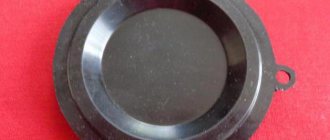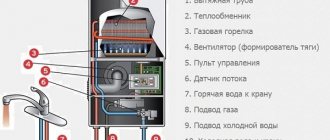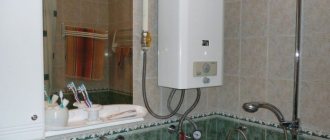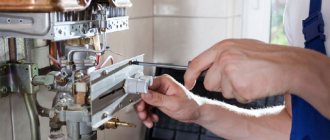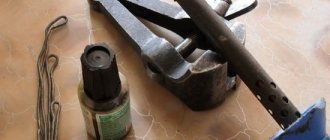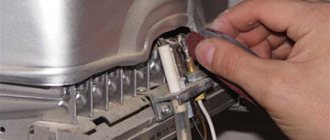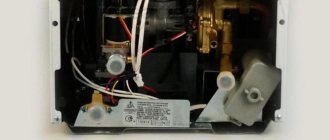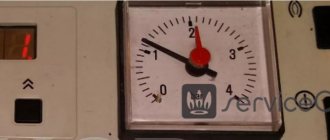Construction of the NEVA gas water heater and principles of operation
Water enters the inlet of the water block, then pressure is created in the block, there is an automatic flow sensor in the block, which informs the control unit about the presence of pressure. also, if there is pressure in the water block, as a rule, mechanically, depending on the column, the gas valve opens. The device has a battery compartment, usually located in the lower part, which directly supplies the control unit, which, when pressure is present, causes the electric ignition to turn on and not go out.
Next, the solenoid valve is opened, through which gas passes to the burner, after which the ionization electrode detects the fact of gas combustion and reports this to the power supply, after which the power supply turns off the electric ignition. Water is heated by heat exchange; the heat exchanger itself is usually located at the top of the column. This information is needed for a general understanding of the operating principles of most gas water heaters, and it in turn gives a little understanding of the principle of their repair.
Neva gas water heater does not light up
The main reasons may lie in various mechanical and electrical parts of the unit. As a rule, such malfunctions of the Neva gas water heater can be eliminated by replacing the worn or broken part yourself, then the device will turn on correctly. But if you cannot solve this yourself, and the device has a valid warranty, then it is best to contact service centers.
Problems in the water circuit
If there is sufficient water pressure and the column does not ignite, you should pay attention to the following tips:
Important! Be sure to shut off the flow of gas and water.
Very often the problem can occur in the rubber membrane in the water block. The membrane creates pressure on the piston, which in turn supplies power to the control unit, the reason is usually a diaphragm rupture. This can be eliminated by simply replacing this membrane. Membranes are quite cheap. Such repairs are quite simple; to do this, you need to remove the casing, dismantle the water block, and disassemble it.
First you need to make sure that the problem is true, the membrane will be torn. Also, before replacing the membrane, it makes sense to clean the water block from plaque and dirt, and also lubricate all moving elements of the block with a suitable lubricant. Next, replace the old membrane with a new one, suitable for the specific speaker model. Assemble the water block and stop it in place. Turn on the water and gas supply and check the operation of the device.
The issue may also be a filter that may be located at the water inlet, which must be cleaned periodically as it becomes dirty. The filter removes impurities that may be contained in the water, and the device will burn and not go out.
Note! The mechanism is turned on when there is sufficient water pressure, but if the pressure is not sufficient, then you should check the water pressure directly in the tap, and if it is not sufficient, then the issue should be resolved by the relevant authorities; if the house is private and water is taken from a well, then it is necessary to solve the problem with pump.
Heat exchanger tubes, as a rule, are also susceptible to blockages. You need to check for these. In case of blockage, it is necessary to clean the tubes, as well as the heat exchanger. To clean the tubes, fill them completely with citric acid and leave for an hour. The heat exchanger should be washed with a solution containing a cleaning agent.
Such solutions can help if the Neva malfunctions in parts responsible for heating and water flow.
Problems in the gas circuit
Common problems in the gas circuit are usually related to contamination of the burner or heat exchanger. To solve the problem, you should clean the gas burner, as well as the heat exchanger; to do this, you should rinse all parts with a solution containing a cleaning agent, and clean the burner with improvised means. The heat exchanger should be cleaned to improve heat transfer.
Note! Cleaning the burner from soot should be carried out in the open air or in a room that is easy to clean, like a bathroom, since soot very heavily clogs the room during cleaning.
Problems in the ignition system
The problem may be related to spark generation. To do this, you need to find out what exactly the problem is. If there is no specific spark, then you should try replacing the battery. Not all Neva speakers are equipped with electric ignition, but Neva Lux 5513, 5514, 5611 are not included in this statement.
If the burner ignition consists of a piezoelectric component, then it is necessary to clean it with wire.
Security problems
A very common problem is the traction sensors. If it is faulty, the gas will not ignite. There are also problems with various sensors that the speakers are equipped with. Self-repair of these sensors, without certain knowledge, is not recommended. also, if one or another sensor malfunctions, it makes sense to replace it, since repairs may not always be effective.
Problems with ignition
Why doesn't the gas heater light up? It happens that there is very little gas pressure in the pipes. Look how the gas stove burners burn. Such fuel supply should be reported to the gas service.
Neva and Vector water heaters have electric ignition. If draft, pressure, gas supply are normal, but the column does not ignite, the reason may be the generation of a spark. When you open the tap, a characteristic cracking sound should be heard. We are trying to replace the batteries.
For water heaters with piezoelectric ignition, such as Oasis, you need to check whether the igniter is working. If the gas in the igniter does not ignite or goes out, you need to clean the nozzle. To do this you will have to disassemble the device.
When using hydrodynamic ignition, you should check the operation of the generator. Such repairs will require certain knowledge and skills.
Gas water heater Astra automatic with electric ignition. The reasons that prevent the device from igniting are still the same. It may also not light up if the gas and water shut-off valves are closed. You just need to open them.
Other reasons
The gas water heater lights up and goes out due to a failure of the mechanism that allows access to the gas. This is a solenoid valve and a servomotor. You'll have to call a specialist.
Over time, the tubes in the column may become clogged. You need to make sure they are passable. In case of blockages, special cleaning agents are used.
Burners in gas water heaters often become clogged. Why is this happening? The reason is the accumulation of soot. It is necessary to disassemble the column, remove the burner and clean it with any tools. At the same time, clean the heat exchanger.
The membrane may rupture. It's difficult to buy.
It is necessary to check all the details. Many speakers have electronic components and sensors. For example, in a Neva gas water heater, the draft sensor often breaks down, as a result the device will not light up.
Electronic components will most likely have to be repaired by a technician.
So, you know what measures to take if the gas water heater does not light. We fix many breakdowns ourselves, and in more serious cases we turn to specialists. When repairing a gas water heater, all safety measures must be observed. Always turn off the gas. It is better to clean the gas water heater outdoors.
Gas water heaters have become widespread due to their availability, high performance and cost-effectiveness. Not only the comfort of the residents, but also their safety depends on how well the gas water heater works. After all, like any equipment consisting of many mechanical parts, a geyser is subject to wear and tear.
The reasons for the incorrect operation of a gas water heater can be associated with both external factors and malfunctions of the internal components of the device. Only by correctly identifying the problem can it be quickly and effectively eliminated.
External factors affecting the operation of the gas water heater include:
- Mechanical damage to the equipment power cable;
- Insufficient ventilation draft;
- Low pressure in the system;
- Gas pressure is too strong or too weak;
- Low water temperature;
- Incorrectly installed pipes;
- Discharged batteries.
In order to diagnose ventilation, you will have to remove the pipe to remove combustion products leading from the gas water heater to the ventilation hole. After this, the draft can be measured with a special device - an anemometer.
Low water pressure in the system (in an apartment building) can be associated both with the supply itself and with clogged pipes.
To understand what the problem is (pipes, or insufficient pressure in the system that does not squeeze out water), you need to contact the housing office. It is the housing maintenance office that must monitor the serviceability of the water supply in your home.
Among the internal factors affecting the operation of the water heater are:
- Wear of elements of the water intake unit (clogged inlet filter, deformation of the water block membrane);
- Clogged heat exchanger tubes;
- Malfunction of gas supply valves;
- Wear of the solenoid valve or servomotor;
- Failure of the ionization sensor (electrode clogged).
In addition, after long-term operation, owners of gas water heating equipment often encounter clogging of the ignition wick. What should you do if your gas water heater stops working correctly?
Problem with poor air flow
The problem is usually associated with a blockage in the exhaust of combustion products; soot may accumulate on them; there may also be a fault in the draft sensor. It is necessary to clean the combustion chamber and combustion product collector. The problem may also be your chimney.
Note! At home, it is possible to clean only the visible part of the chimney; specialists should clean the rest of the chimney. To check the air flow, you can use a lit match; to do this, you need to bring it to the window on the panel. When the flame deviates, we can conclude that there is an air flow.
No spark
To understand why there is no spark, you should pay attention to the ignition. The problem may be a malfunction of the electric ignition or piezo ignition. To solve this problem, it is necessary to inspect the electrical parts to make sure that the ignition is working.
Note! In the event of a malfunction, the electrical parts should be replaced, since it was previously said that if there is a lack of necessary knowledge, it is not worthwhile to repair the electrical parts yourself.
Tips for preventing problems at geysers
For successful, safe and long-term operation of Neva speakers, you must adhere to the manufacturer’s instructions, as well as a number of simple rules, among which the most important point is the timely replacement of filters.
Note! In addition, the chamber should be cleaned and the igniters inspected from time to time. Problems that can be prevented, namely problems with clogged heat exchanger tubes, as well as membrane wear, can be solved by installing additional water filters at the inlet.
If you identify any difficulties or questions in the operation and setup of geysers, it is advisable to immediately contact qualified technicians who will quickly and accurately diagnose the breakdown and set up the device. However, there are errors that you can eliminate yourself. All these questions are answered in this article.
Posted by Niels · September 1, 2016
Let's consider one of the first and most common problems of geysers, a weak spark discharge or its absence. Such a malfunction of the geyser is quite common and it does not appear a year or two after using the equipment, but after a few months.
Symptoms are usually the following. Just yesterday the gas water heater worked like a clock, but today it suddenly didn’t turn on. You close the hot tap, open it again - the column is working. Then, every day more and more such manipulations have to be done (opening and closing the tap). And then finally the moment came when it stopped working completely. Then just call a technician or fix the problem yourself.
What to do: the gas water heater does not light up (video)
A geyser is an affordable equipment that allows you to quickly and efficiently heat water for both the heating system and domestic use. The comfort and safety of apartment residents depends on the proper operation of a gas water heater. But don’t panic if the gas water heater is broken: most problems can be easily fixed with your own hands. You just need to correctly identify the fault. The above tips will help you with this!
The Oasis gas water heater won't light? Many users face this problem. The causes of failure are external and internal. Do you want to restore the operation of the water heater and not be left without hot water? With us you will learn: how to determine the cause of the problem, ways to fix the problems yourself.
Gas water heater malfunction and causes
Having removed the gas column cover and opened the tap, you see that there is no spark discharge. So why did the spark disappear, what is causing the malfunction?
1. Reason not related to failure of any part. 1.1. Insufficient water pressure.
First, check the position of the temperature control knob, which is responsible for the pressure of the water flow at the inlet of the gas water heater. At low pressure the column will not turn on. Turn the handle counterclockwise all the way to the far left, and then open the tap. If the dispenser starts working, there is probably low pressure in the suitable pipes and the cause should not be looked for in the dispenser.
1.2. The appearance of scale in the radiator.
When using hard, calcareous water, scale may form on the walls of the heat exchanger, which also affects the creation of the pressure necessary for the operation of the gas water heater. To remove scale, you will need to remove the heat exchanger; note that you will have to disassemble almost the entire column. Prepare a 10% solution of citric acid: stir 100 grams of lemon in one liter of warm water. Pour into the heat exchanger tubes and leave for 15 minutes. Drain the solution and rinse thoroughly with water. It is recommended to carry out cleaning at least once a year.
2. Souring and immobility of the rod.
Oxide may form on the rod located next to the microswitch. This in turn affects the mobility of the tongue and the closing and opening of the circuit contacts. To clean the rod, you need to remove the microswitch and release the fixed tongue.
3. Fault in the electrical circuit between the microswitch and the control unit.
Also, a malfunction of the gas water heater due to the lack of a spark can be caused by a violation of the circuit between the switch and the control unit. To do this, check the terminals connecting them and the switch wires. Possible oxidation of contact points.
Why does the Oasis water heater not light up?
Let's look at the main reasons why the device does not turn on, there is no spark. Let's see how to identify the malfunction and restore the operation of the equipment.
The batteries are low
The automatic electric water heater is powered by batteries. As soon as you open a water tap, the batteries produce current. It passes through the circuit to the control unit, which sends a signal to the candle to ignite. This is how automatic ignition occurs.
Knowing this, it is easier to understand why you need to monitor the condition of your batteries. If they are discharged, install new ones; it is better to choose alkaline ones with a good charge LR20. Weak, cheap batteries will not be able to ensure stable operation of the equipment.
- Open the battery compartment by turning the handle.
- If you notice signs of leakage, be sure to clean the contacts.
- Install the correct items.
If after replacement the column does not produce a spark, you need to look further for the reason.
Traction problems
Without traction, the equipment will not work. Safety mechanisms will prevent the igniter from igniting. Why? Because draft problems are caused by blockages in the chimney. This means that when the device is triggered, combustion products will go outside and enter the room. To avoid an emergency, a draft sensor and a flame sensor are installed.
Why does the chimney duct become clogged?
- Leaves and debris from the street get into the hole.
- During operation, soot accumulates in the passage.
Hole needs cleaning. If you cannot do this yourself, contact your utility company.
How to understand that there is no traction:
- Place a burning match near the control window or ventilation.
- When the chimney is working, the flame will deviate to the side. If the flame burns evenly, there is a blockage.
Pressure problems
Incorrect settings may cause the problem. The water pressure regulator is turned off or at the minimum level. Turn it to the working position to increase the pressure in the system.
If a thin stream of water flows from the tap, the reason is a decrease in pressure in the common line. You need to wait until the supply is restored. Alternatively, you can install a circulation pump: then the supply will always be stable.
Strainer clogged
A protective filter is located at the inlet of the column. It protects the system from small debris and rust from the water supply. Over time, it becomes clogged and the water pressure decreases. Therefore, the turbocharged column does not ignite.
- Unscrew the nut.
- Remove the filter.
- Rinse it under running water.
- Brush with citric acid.
You can purchase a new part and install it in place.
Water unit membrane malfunction
Stretching, wear or damage to the membrane leads to malfunction of the entire device. The working part creates pressure on the gas valve, which opens and releases fuel into the burner. You can read more about diagnostics, choosing a new element and replacement in the article “”.
It is important to tighten the screws carefully and evenly after replacement so as not to damage the rubber diaphragm.
The heat exchanger is clogged
Water is constantly circulated and heated in the radiator coil. When heated above 55 degrees, scale begins to settle: magnesium and potassium salts, which are contained in hard water.
How to prevent the appearance of scale? Install a water purification filter. Do not select high temperature, maximum 55°C.
Oil seal leaked
Leaks can be detected by removing the device casing. To fix the problem, you need to replace the part.
- To do this, unscrew the water unit, divide it into two parts after unscrewing the fasteners, and remove the membrane.
- Then remove the rod with the seal.
- Replace the seal and seal.
- Then reassemble the structure in reverse order.
Check the operation of the rod: it should move normally. If it is rusty and soured, it needs cleaning and lubrication.
Other problems with Oasis Turbo:
- The microswitch is broken. The part cannot be repaired; installation of a new switch is required.
- The wiring is broken. Inspect the cables and the tightness of the contacts to the main components. If the insulation is damaged, the wire must be replaced.
- Solenoid valve malfunction. It is necessary to install a working valve.
- If the electronic unit breaks down, it needs to be examined by a specialist.
- Piece doesn't work. The piezo ignition button does not work; the contacts may have oxidized. Inspection and cleaning are being carried out.
These are typical problems with Oasis water heaters. If your equipment does not ignite, use our recommendations to troubleshoot the problem.
The situation when the gas water heater does not light up is, of course, unpleasant, but it is too early to panic. By following simple precautions, it is quite possible to identify and fix the problem yourself, sometimes without even resorting to the help of a specialist.
Device and principle of operation
In many cases, fixing a problem with automatic ignition or with other components of the device is quite easy, and you don’t even have to seek the help of professionals. However, in order to understand why the Neva geyser does not work well, it is worth studying its structure.
The system includes:
- housings (for wall-mounted models - supplemented with mounting loops);
- heat exchangers made of copper;
- water circulation units;
- burner complexes;
- concentrators of gaseous combustion products (diffusers);
- pipes for connection with the chimney;
- water supply tubes;
- igniter electrode;
- faucet regulating the passage of water;
- segment for batteries;
- a system that regulates heating power and fuel consumption;
- ionization fire indicator.
The typical method of operation of a gas burner is very simple. As soon as the water tap supplying hot water is opened, the pressure of the jet begins to act on the membrane of the control unit. Under its pressure, the rod moves, which opens the gas valve, and the contacts of the switching device close. Through the electrical circuit, current from the batteries begins to flow to the controller. The electronics sends two signals at once: one by one, the valve opens, allowing gas to pass through; the second, an electric spark appears on special electrodes.
As soon as the fire detector detects characteristic ionization, it sends a signal to the central automation. It stops initiating the spark. Heating is carried out in standard operating mode. The mixer valve is closed. The membrane immediately moves back, and the gas passage valve closes.
At this moment, the limit switch is activated, stopping the flow of current to the controller. Without power supply, the electromagnet remains. Since no gas enters the burner, it should go out immediately. The valve is connected to the same circuit as the draft meter. When this draft disappears or is weakened excessively, the heated sensor opens the circuit, thereby stopping the power supply to the electromagnet and the passage of gas to the burner.
Problems and causes of their occurrence
Knowledge of the basic principles of geyser design is very useful. But it is important to take into account that faults in each model may be different; they are determined by the characteristics of the technical system and design weaknesses.
Model 4510 M is not superior in reliability to most Russian gas systems, that is, it is noticeably inferior to foreign analogues. Most often, users complain that the speaker turns on poorly or does not turn on at all. The inability to turn on the column may be due to the fact that the required water pressure is not provided.
Another problem is that the handle that regulates the rate of water flow is incorrectly set. It is very easy to fix such a defect. The solution simply comes down to moving the lever to the left position, which sets the most intense passage of liquid. Another possible failure is that the stem of the unit that regulates the flow of water remains motionless when the tap is opened.
The reasons for this condition are:
- stretched membrane;
- rupture of this element;
- fracture of the plate containing the rod.
Occasionally it is discovered that the gas rod does not work. Such a problem cannot be ignored, because it does not allow the water rod to be moved to the right place. A sign of such a breakdown is that the column does not start working when the water is turned on, it lights up only after several attempts, and it can also be difficult to turn it off.
Other problems specific to this speaker model:
- switch damage;
- open power supply circuit of the thermal relay;
- damage to solenoid valves or relays;
- there is no spark created by the electronic unit;
- dead batteries.
Problems may also occur with models from the Lux group. Quite often there is a situation when a spark does not run from the candle to the fuse after the water has passed through the device. As with the previous model, this can be caused by low water pressure. If its adjustment fails, if the column still does not light up and does not heat the water, it is necessary to clean the filter systems and heat exchanger. The last measure is to eliminate the cause of low liquid pressure, sometimes by contacting water utility structures and other relevant organizations.
In addition to installing working batteries, it is important to monitor the polarity of their placement. It happens that water flows, a spark jumps, but the flame still does not ignite. The probable cause is saturation of the gas line with air.
Only employees of official service organizations have the right to fix such a problem. The owners themselves can only fully open the shut-off valve of the gas pipeline.
In some cases, the burner burns sluggishly, the fire in it is elongated and smokes. The cause appears to be the accumulation of dust particles on the nozzle or internal structures of the burner. Cleaning helps to cope with this condition. When the column turns off without permission, it can be assumed that the draft in the system is insufficient.
In such a situation, you will have to clean the chimney and check its tightness.
If such measures do not produce results, it will be necessary to examine the electronic control units and main sensors. But sometimes the burner goes out for another reason - due to an excessive increase in water temperature.
In such a situation you need:
- turn off the supply to the hot water circuit;
- re-ignite the column after 60-120 seconds;
- when re-igniting, set a lower warm-up temperature by setting a reduced gas flow rate or an increased water emission.
When a gas heater clicks as if a spark is being formed, but there is no ignition, the defect may be associated with the insulation of the spark plug or with depressurization of the cable connecting the burner and the control unit. All these moments cause an electrical breakdown on the housing and must be eliminated immediately.
Malfunctions of geysers Neva Lux 6011 and 6014
___________________________________________________________________________________________
- Neva Transit - Troubleshooting
- Neva 3208 - Troubleshooting
- Recommendations for use of Neva 4510, 4511, 4513, 4610
- Adjustments and repairs Neva Lux 5513, 5514, 5611
The causes of the most frequent breakdowns of gas water heaters Neva Lux 6011 and 6014, which lead to malfunctions, are considered, and repair methods are described. These models are the same, they differ only in rated power. There is no spark between the spark plug and the pilot burner . When hot water is supplied to the tap, it begins to flow through the device. In this case, the indicator does not light up, indicating that heating has begun. Reasons for incorrect operation: 1. Water supply is too weak. To solve this problem it is necessary to increase the pressure. It is necessary to check the pipes installed for water supply. Perhaps their diameter is too small. 2. Damage to the batteries; they may be installed with incorrect polarity. It is necessary to install new ones, or rearrange them correctly. If the contacts are heavily oxidized, they need to be cleaned. 3. Flow sensors do not work. They cannot be repaired; if this is the problem, you need to buy and install new ones. These models are equipped with fairly cheap spare parts, which is why they often break down. 4. Damage to the water unit. There may be a problem with the membrane. To repair it you need to get it out. Deformed or torn ones need to be replaced. 5. Damage to the electronic control unit. You need to contact a specialized service center to have them install a new one. Error E0 Column Neva Lux 6011 stops working. No gas supply. It is possible that the valve is closed, or there is no gas in the line. Error E1 Within 1 minute after the device starts working, the electronic unit does not receive a signal from the sensor that monitors the presence of a flame. Possible reasons: 1. Air pockets have formed in the gas pipes. Such a defect most often occurs during the first start-up, or after the device has been idle for a long time. To solve this problem, you need to open the hot water supply tap to the flow, after a minute you need to close it. And repeat this until the problem with the air lock stops and the boiler starts working. 2. The gas valve is closed or not fully open. It is necessary to open it completely. 3. Gas supply pressure is too low. It is necessary to check the gas hose; perhaps its diameter is lower than required. If this is not the problem, you need to contact GorGaz, apparently they drop it with low pressure. 4. If the unit is powered by liquefied gas in a cylinder, then it may be necessary to install a new cylinder. 5. Problems with the connection between the electronic control unit and the fire sensor and the solenoid valve of the pilot burner. To solve this problem, you should check the contact and restore it in case of malfunction. 6. The flame detection sensor is located too far from the burner. It is also possible that the electrode is in contact with the burner body. To solve this problem, you need to install the sensor as described in the instructions. The electrode should be engulfed in flame, but not touch the burner body. 7. The pilot nozzles or air passages are too dirty. To solve this problem, you must contact customer service. 8. The solenoid valve is broken. A new one needs to be installed. 9. The distance between the spark plug and the burner is incorrectly set. The gap should be approximately 4 mm. 10. There is too much dirt and soot on the electrode or flame sensor. They need to be cleaned using copper wire or a brush. After the repair has been carried out, it is necessary to ensure that the tightness is maintained. For this, a soap solution is used. 11. There is no contact between the spark plug and the high-voltage wires. Check and fix. Error E3 The solenoid valves begin to operate not from the signals supplied by the water flow sensor, but earlier. 1. Malfunction of solenoid valves. Necessary to buy and install new ones. 2. Damage to the electronic control unit. A new one needs to be installed. This work may only be performed by specially trained professionals. Error E7 The main burner lights up and goes out at least 7 times. Causes of failure: 1. Gas supply pressure is too low. Check and, if necessary, open the gas supply valve. Make sure that the pressure in the line is sufficient; if not, then write a statement to the gas supplier. 2. The flame sensor does not touch the fire. It needs to be positioned correctly. 3. Damage to the solenoid valves. To replace it, you must call a service technician. 4. The rods of the SF6 water units began to boil. New installation required. 5. The flame sensor electrode is very dirty. A lot of soot has accumulated on it. Use a metal brush to clean it. Error E8 The draft sensor triggered and turned off the Neva Lux 6014 column. Before the error appears on the display, the water heater pauses for 5 minutes after stopping operation. This only happens if the hot water tap is open. 1. There is no draft in the chimney. Most likely it is clogged and needs cleaning. It is also important to know that these devices are not designed to work with forced exhaust. You need to make sure there is traction. 2. The sensor that signals the presence of traction is faulty. It is necessary to check it, clean the contacts if necessary. If it cannot be repaired, a new one must be installed. Error LO There is not enough gas for the water heater to operate stably. This is a very common mistake on these models. 1. An error is observed if the water flow is below 3.5 liters per second. To solve this problem, you can increase the water supply, and you should also rinse the heat exchanger from scale. For this purpose, special reagents are used to remove limescale. If it is not possible to buy, then it is allowed to use a solution of citric acid or vinegar. 2. The difference between the water supply temperature and the required heating temperature is too small. To solve this problem it is necessary to increase the delta between the temperatures. 3. The system pressure is too high. To reduce it, a special reduction gear is required. Operation and repair I put into operation the Neva Lux 6011 gas water heater. The gas is connected to a centralized main, and water comes from a well. There is also a pumping station, a pressure switch, and a hydraulic accumulator. A pressure reducer is installed at the outlet of the device, which is adjusted to operate at 1.5 atmospheres. The problem is this. When I open the household tap, the water heater starts working, and immediately starts at maximum. In this case, the water heats up to 90C, after which the L0 error appears and the device stops working. After this, the apparatus flares up again, and at this time the gas is supplied initially with minimal pressure, and then gradually increases it until the water is heated to a temperature of 45C. At the same time, the unit continues to operate without any problems on its part. And this continues until you stop the water supply. But it also happens differently. When the hot water supply opens, the column starts working at maximum again, but the water only heats up to 80C, and then the flame dies out and the water cools down to 45C. After this, the operation of the device is stable. I don’t understand why these overheats occur when the water heater is started. Is it possible to somehow stabilize the work? On this model, a gas block from a 30 kilowatt device is installed on the control board. This is precisely why problems arise. The control coefficients do not always correspond to the installed heat exchanger and burner if it is less powerful. Accordingly, this is what causes overheating. If you set the temperature lower, the heating will be less. But you cannot completely prevent it. This is how the controller works. The original water heater is equipped with a more massive heat exchanger and a stronger burner. This is what makes its thermal inertia higher. Therefore, it implements an increase in the starting gas supply so that it reaches the operating mode as quickly as possible. Model 6014 works more correctly, but still this line all has such defects. They work normally for no more than 2 years. Can I install a board from another Neva on my Neva Lux 6014 speaker, which implements a more suitable operating algorithm for 21 kW. Or is it possible to somehow make an adjustment? With these boards, only one adjustment is possible, and that is to switch to a different type of gas. My Neva lux device worked for me for 2 years. I have already come to terms with the fact that gas is being thrown too. It still did not reach the L0 error. But I periodically heated the water to 70 degrees. If you have a hydraulic accumulator installed, then the device works even worse, since it contains warmer water. After turning it on, a very large volume of gas enters the apparatus itself, and the initial temperature of the water is also higher. As soon as the column began to produce such an error, I immediately sold it, but warned the buyer that he would soon have to change the gas block. And it is expensive. I believe that this model is very unsuccessful and should be replaced. I installed a branded turbocharged water heater and there are no problems. We use the Neva Lux 6014 column for household needs. I read different reviews and came to the conclusion that each model has its own pros and cons. For example, if we take an imported model, they have a faster response time to pressure changes, as well as to the fact that a second tap is connected to the water supply. Neva is slower in this regard, and also, if we consider model 6014 separately, it makes a lot of noise. Accordingly, I have a number of questions. For example, if the water temperature is constantly unstable, how can I take a shower without getting burned? And that's what I thought. If I install an electric boiler with a volume of about 20 liters after it, then the water will accumulate in it and then flow into the tap. If I set the temperature on both devices, for example, to 40 degrees, then the problem, it seems to me, will go away. I open the tap, and there is already water at the temperature I need. And even if the device overheats to 55 degrees, water will still get into the tank. There it will mix and cool, and the output will still be about 40 degrees. This way I can't get burned. And also, for example, if I’m taking a shower, and at that time someone in the kitchen starts washing dishes, I don’t have to wait until she starts heating the water more intensely. The storage tank will be able to compensate for temperature changes. Moreover, I think that the boiler does not need to heat the water, it will work exactly on the principle of a thermos. Even if it turns on a couple of times to maintain the temperature and consumes a little electricity, this is an insignificant loss for solving a global problem ahead of schedule. Do you agree with me? You are right, this scheme will work. There will only be a small consumption of electricity, which will be used to compensate for heat loss in the boiler. It is usually installed with contour boilers. I had a Neva Lux 6014 water heater installed a year ago, and it worked well until it broke. More precisely, it turns off and that’s it. It works for no more than 5 minutes and shows an LO error. What's wrong with me? Most likely this is how the traction sensor behaves. You can check it out. At the top of the chimney on the left side, if you reach out with your hand, you can feel it. If it is hot, then the draft is broken. And if it’s cold, then the sensor is broken and you should buy a new one. A new gas water heater Neva Lux 6011 is in operation. It worked for less than a year. After I start it, the ignition is triggered almost immediately, while the main burner is working. And this lasts about 20 seconds, and after that the LO error appears. I checked the water pressure, it is good. I don’t understand why the ignition turns on when the burner itself is working. To solve the problem, I tried removing and cleaning the flame sensor, but this did not solve the problem. I carefully watched how the device worked. And that's what I noticed. After ignition it starts working. Then the flame begins to slowly decrease, but does not disappear completely. And it is at this moment that the ignition begins to work. The flame gets bigger again and then gets smaller again. And again the ignition. After several attempts, error L0 appears. And today it got even worse. After the same error appears, the main burner turns off. The unit can no longer be started. The igniter works, there is a spark, but the main burner does not react. It can only be started after it has been idle for 15 minutes. From the above we can conclude that since the main burner lights up, it means the control unit sees the flame. If this were not the case, it would not supply gas to the main burner. You need to set the correct gap between the electrode and the torch body. The distance should be about 4 mm. You must also ensure that the electrode is in the flame. Very often the regulator with minimum output breaks down. To solve the problem, you should adjust the control electrode so that flame control is maintained even in the minimum operating mode. If you do this, the device will start itself, exiting the error. But why such problems with the regulator, especially since this happens in all these models, is the question. The regulator is designed to set the burner power. Simply replacing the electrodes will not solve her problems. You just need to position it so that it constantly sees the flame. I once had such a unit, and I even tried to install a new control unit on it. This doesn't solve the problems. There is the following problem with my Neva Lux 6011 gas water heater. If you look at the flame, it is present at medium intensity. The temperature is set as I require, but the water does not heat up. I tried rebooting the controller, cleaning the electrodes. I even checked the gap. Could there be a problem with the temperature sensor? If I set the temperature to low, for example 35 degrees, then the LO error appears. In this case, the column lights up once and goes out. If you set the temperature in the range from 35 to 55 degrees, then the water heater sets the minimum flame mode, and at the same time very slowly. After some time, the column decides that the water is already boiling, as shown on the indicator, and the flame turns off. And this error appears again. If you set the water temperature to about 60-70 degrees, then the device works as I wrote at the very beginning. Moreover, the flame depends on the pressure. The water barely warms up. This means that my gas valves are most likely working properly. I tried changing the main valve diaphragm and stem, but that didn't help. The problem persists. Of course, it has been in operation for 4 years, and such updates will be useful to it in any case. Most likely the problem is with the sensor rather than with the controller. This error occurs because the controller reaches a minimum, and the signal from the sensor is incorrect, and shows that the water temperature is still high. Well, it’s very easy to change, it’s cheap. Error E7 appears. To fix the problem, I checked both valves, installed a new control unit, replaced all the membranes, and also checked the rods where the softness of operation was impaired. I installed new batteries. I checked the traction sensor and gas pressure. Made sure all filters were clean. But I still haven’t solved the problem. When ignited, the pilot burner starts to work, and then the main burners light up from it. This is repeated twice, and then an error is displayed. I also cleaned the ionization sensor. And he also raised and lowered it. The moment the wire was removed from the sensor, the burner stopped going out. The pieza began to work continuously, and nothing could be fed to the main burner. If I connect the wires to the ionization sensor, everything goes out. I tried removing the sensor and attaching a wire to it. All the same. If I connect the igniter flame sensor with the wires on, the igniter immediately goes out. I don't have an ionization sensor, so I can't check at this point. What could be the reason? Ionization should work in any case. So that's not the problem. First, the controller sees the pilot burner flame, and then it supplies voltage to the main burner ignition valve. It was necessary not to change everything, but to try to find out the reason. And it is in a faulty water temperature sensor. It just needs to be replaced. Methods for replacing batteries To replace the batteries in the Neva Lux 6011, 6014 geyser, it is necessary to shut off the gas water supply to the device for safety reasons. The battery compartment is located in the farthest lower right corner. To replace, you need to open the box and turn the retaining flag 90 degrees counterclockwise. The box is closed with a lid with hinges. In it, the batteries are arranged vertically, they are snapped into place by flexible L-shaped plastic fasteners. To remove the batteries, you need to carefully remove the latches, thereby releasing the batteries. After installing new batteries, you need to close the lid and secure the box from opening by turning the flag counterclockwise to the maximum. All these models operate on D-type batteries with a voltage of one and a half volts. The manufacturer recommends installing the alkaloid model LR20, since they have increased capacity. Used batteries can only be disposed of by handing them over for further recycling. Also, when installing batteries, it is important to take into account their polarity. If there are doubts, you can see a hint located on the container cover from the inside. If, for some reason, there is no hint that the spring always comes into contact with the minus.
___________________________________________________________________________________________
___________________________________________________________________________________________
Electrolux geyser I have an Electrolux GWH 275 SRN installed. The apartment is rented and when I moved in, the renovations had not yet been completed. I had to complete it. During renovation...
Ariston geysers On top, the Ariston geyser has an outlet for connection to the chimney system to ensure the mandatory removal of combustion products outside the home. The main task...
The Vektor Lux Eco gas water heater lights up, but after a while it stops working. There are several reasons for this behavior of a gas burner. Here are some of them. Bad...
Oasis geysers I have been using an Oasis 20 kW geyser for two and a half years now. After about 6 months of use, problems began with it. In winter mode...
Bosch geyser We use a Bosch W 10 kb geyser. The passport says that the country of origin is Germany. It has been working for more than 10 years, and there have been no problems with it. It was only...
Junkers geysers I have a Junkers WR 275 geyser installed. I set the gas supply and water pressure using regulators. Moreover, I adjusted it so that the water was supplied at 45 degrees. Today…

